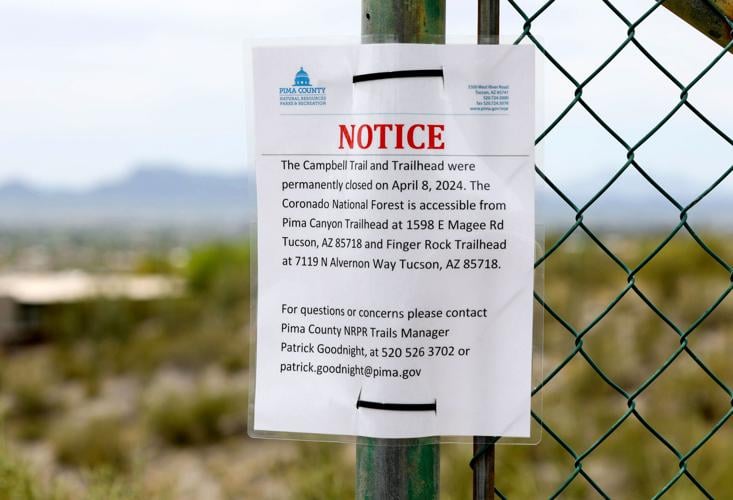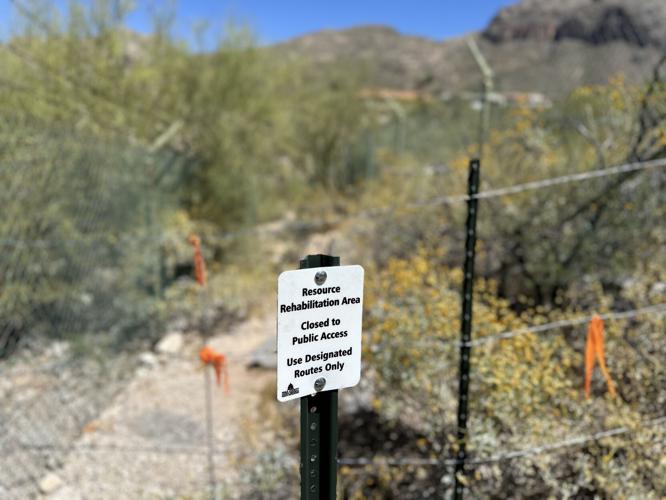Fifty years ago, as residential development pressed closer to the mountains surrounding Tucson, a group of hikers and environmentalists joined forces with local officials to preserve public access to some of the wild lands that remained.
The resulting trail access plan, adopted by the Pima County Board of Supervisors in 1976, called for the acquisition and permanent protection of more than a dozen urban trailheads, including nine leading into the Santa Catalina Mountains.
One of those decades-old access routes is now permanently closed.
Early this month, county officials quietly shut down the trail and trailhead at the north end of Campbell Avenue. The paved parking lot has since been torn out and the entrance to the trail blocked with a wire fence.
“Permanent closures are rare but do occur,” said Victor Pereira, director of Natural Resources, Parks and Recreation for the county.
In this case, the half-mile trail leading straight north into the Pusch Ridge Wilderness Area was decommissioned because it did not connect to any established U.S. Forest Service trails in the Catalinas and did not meet the county’s standards for safety and accessibility, Pereira said.
For example, one 200-foot segment of the trail climbed a rocky slope at a 35% grade, “more than triple the acceptable maximum of 10% for a segment of that length,” he said. Since the entire trail easement was only about 10 feet wide, there simply wasn’t enough room to replace the steep stretch with switchbacks or climbing turns.
Pereira said the county also received complaints from nearby residents about people parking illegally at the Campbell Trailhead after dark, making noise and leaving behind trash and graffiti, but he insists that was not the reason for the closure.
“We don’t close trails just because of that. That’s just part of doing business,” he said. “The bottom line is that we decided to close the trail because of a lack of trail connectivity (and) the substantial investment of resources required to improve the trail in accordance with our standards.”
But that decision isn’t sitting well with some of the people who fought to protect public access to the Catalinas in the first place.
Barbara Coon is a long-time member and the current program chairwoman of the Southern Arizona Hiking Club, Tucson’s oldest and largest group of outdoor enthusiasts. She was involved in some of the early discussions that led to the county’s adoption of the trail access plan 48 years ago.
“That plan stood the test of time — until April 8, 2024,” Coon said. “What gives them the right to close anything that’s in that trail plan without notice? Is this the thin edge of the wedge? What’s (going to get closed) next?”
Down the chute
In some ways, the Campbell Trail was the perfect symbol — albeit a strange one — for the tension between private land development and access to neighboring public lands in Tucson.
The path was cut along the property boundary between two future gated communities, forming a narrow right-of-way aggressively hemmed in on either side by 8-foot-high, chain-link fences, angled inward at the top and crowned with barbed wire.
Over the years, the trail at the end of Campbell drew comparisons to a cattle chute, a dog run, a prison yard and the demilitarized zone between two warring nations.

Before it was permanently closed by Pima County om April 8, the Campbell Trail, shown here in 2021, featured one of Tucson’s strangest hiking experiences: a walk between two 8-foot fences topped with barbed wire.
In the Arizona Daily Star in 1981, outdoors columnist Pete Cowgill described it simply as a half-mile “public access corridor between chain-link fences” that led to a wilderness area at “the rugged lower end of Finger Rock Ridge,” where there are no other trails.
To Cowgill, father of the Southern Arizona Hiking Club, this wasn’t folly. This was proof that Pima County’s trail access plan was working.
He must have felt a bit like a proud parent. After all, his hiking club had played a leading role in the plan’s development, though the county’s trail access citizens advisory committee also included such diverse participants as the Sierra Club, the Southern Arizona Sportsmen and Gun Owners Association, the Arizona Game and Fish Department and the Tucson Gem and Mineral Society.
Coon said the development of the plan was a fight to save what access was left before it was gone.
“In those thrilling days of yesteryear, the county was handing out building permits like candy, and the desert was getting scraped. The people were wondering what we could do,” she said.
It took years of work, but a deal was eventually struck that everyone could live with, even celebrate, Coon said.
“The county and the citizens had an agreement. We all came to a conclusion, and we all came away smiling,” she said. “How dare they tear that all up now.”
No connection
According to Pereira, the Campbell Trail was the only county-managed access route that led into a wilderness area but did not connect to an established trail there.

A steep section of the Campbell Trail as it looked in 2021.
Leaving it open, he said, would have “encouraged well-meaning hikers” to forge their own path through an area that is closed to off-trail use from January through April to protect bighorn sheep during lambing season.
County officials always hoped that the Campbell Trail would one day be tied into the larger Coronado National Forest network, Pereira said. The county even lobbied the Forest Service for a connector trail, he said, but the agency never seemed to embrace the idea.
Last year, the Forest Service released a sweeping new Santa Catalina Trail Plan, but no link to the county’s access route at Campbell Avenue was included among the 54 miles of new trails slated to be built over the next 15 years.
At that point, Pereira said, it was clear to the county that the connection would never be made.
He knows some people aren’t happy about the trail closure, but he suggested a little perspective might be in order. Over the past five years alone, he said, Pima County has added about 75 miles of new “natural surface” paths to an overall trail network that now stretches roughly 170 miles.
As for the Pusch Ridge Wilderness Area, Pereira said it can still be accessed on two other, well-established routes with ample parking: the Iris Dewhirst Pima Canyon Trailhead and the Richard McKee Finger Rock Trailhead, both within five miles of the end of Campbell Avenue.
It’s unclear how much use the Campbell Trail actually saw before the county closed it. Pereira described it as a “low-usage trail” but couldn’t provide any visitor count data to back that up.
Clearly, someone must have been hiking there. Jim Terlep, trail access coordinator for the Southern Arizona Hiking Club, said that within two days of the closure, he’d already heard about it from eight different angry hikers, several of whom don’t even belong to the club.
But the trail’s popularity is irrelevant, as far as Terlep is concerned. “(Low) use is not a reason for closure,” he said.
It doesn’t need to connect to an established Forest Service trail to have value, either, because it still provides access to the wilderness area, he said.
“This is the first time in living memory that the county has closed a trail or trailhead,” Terlep said. “On top of that, it was done without prior public notice or input.”
Campbell Cliffs
Hikers and rock climbers started using the end of Campbell Avenue to make their way into the Catalinas at least a decade before the county agreed to develop an official trail there in 1976.
Just ask David Baker, the Tucson native who founded the Summit Hut outdoor retail business as a teenager in 1968.

A sign and a wire fence blocks the path of the Campbell Trail on April 26. The half-mile hiking route into the Catalina Mountains from the north end of Campbell Avenue has been permanently closed by Pima County.
Back then, Baker said, the trail provided access to an outcrop known as the Campbell Cliffs, a popular practice spot for people like him in the days before climbing gyms.
Keeping public land open and accessible isn’t just the right thing to do, Baker said. It can also benefit the local economy.
“There are a lot of people who come here to enjoy the wild spaces in Pima County,” he said. “I imagine some of them drop some money when they do.”
Though Baker hasn’t climbed any cliffs or walked the Campbell Trail in decades, he said he’s still sorry to see the old trail go.
“It’s a shame,” he said. “Access to public land is an ideal that’s worth working for and protecting.”
The Campbell Avenue trail has been permanently closed after more than 40 years.







